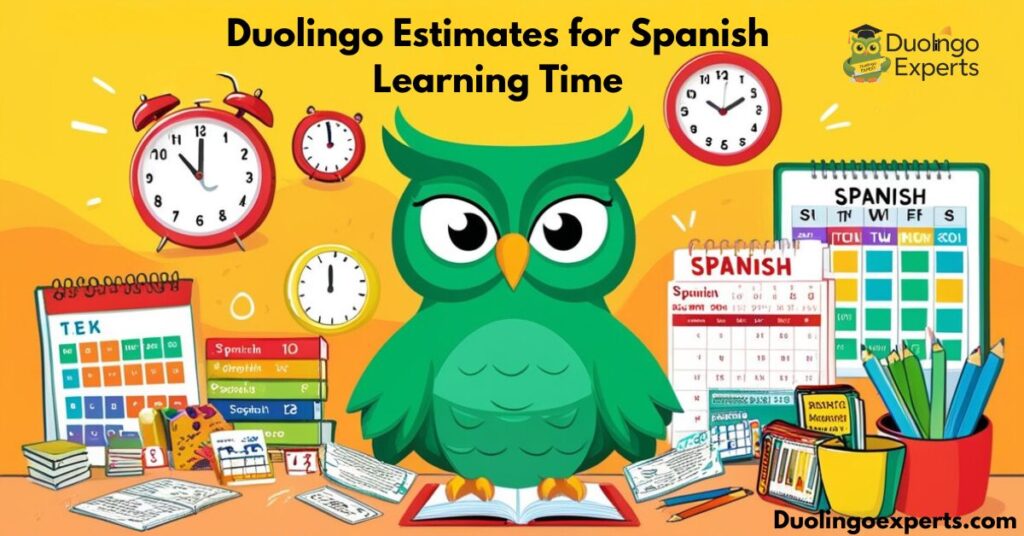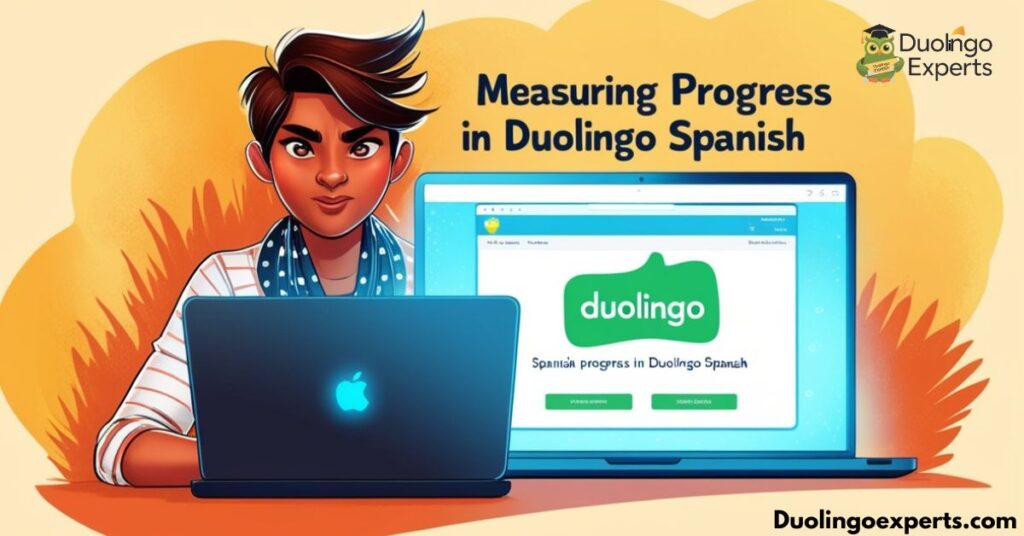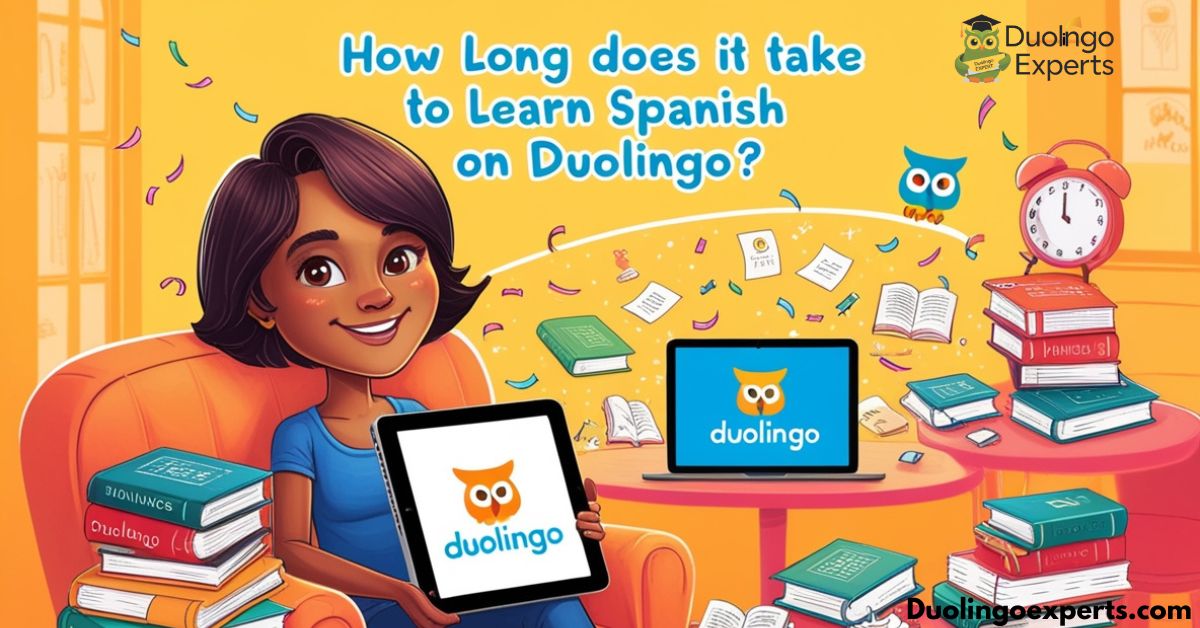Learning a new language can be a rewarding yet challenging journey, and Duolingo has made it easier for millions to study Spanish with its fun, interactive platform. But just how long does it take to learn Spanish with Duolingo? Is it a fast track to fluency, or is the process more gradual? In this post, we’ll dive deep into the Duolingo Spanish course structure, examine factors affecting learning time, and give realistic expectations for anyone looking to study Spanish using the app.
Understanding Duolingo Spanish Course Structure

Sections and Units in Duolingo Spanish
Duolingo’s Spanish course is divided into different sections and units designed to guide learners through progressively more complex material. Each section focuses on different aspects of the Spanish language, such as vocabulary, grammar, and speaking practice. From learning simple greetings and food vocabulary to tackling more advanced topics like Spanish verb conjugation and subjunctive forms, Duolingo ensures that users can start at the very basics and move toward conversational fluency.
Key Features of Duolingo’s Spanish Course:
- Vocabulary practice: Each unit introduces new words and phrases tailored to everyday situations.
- Spanish grammar: Early lessons focus on basics like verb conjugations, while advanced units tackle more complex rules.
- Skills development: Duolingo incorporates listening skills, speaking practice, reading, and writing in a balanced way.
- Interactive exercises: Gamified learning keeps you engaged with XP points, crowns, and streaks that track your progress.
Lessons and Skills Covered
As you work through Duolingo, you will cover essential aspects of the Spanish language:
- Basic Greetings & Phrases: Start with simple greetings like “¡Hola!” (Hello) and “¿Cómo estás?” (How are you?).
- Everyday Vocabulary: Build your vocabulary around themes like food, family, travel, and weather.
- Pronunciation and Speaking Practice: Learn how to pronounce words correctly with Duolingo’s speech recognition system.
- Verb Conjugation: The app introduces conjugation gradually, starting with regular verbs and moving toward irregular verbs and tense usage.
- Complex Sentences: Eventually, you’ll learn how to structure more sophisticated sentences, improving your fluency and understanding of Spanish grammar.
By completing these lessons, Duolingo helps you transition from Spanish beginner to intermediate, giving you a solid foundation for conversational Spanish.
Factors Affecting Spanish Learning Time with Duolingo
When it comes to how long it takes to learn Spanish, several factors play a role in determining your progress. While Duolingo provides a structured approach, the pace at which you advance depends on your personal learning habits and goals.
Prior Language Learning Experience
If you already speak another Romance language like Italian or French, you may find learning Spanish much easier. These languages share many similarities in terms of vocabulary and grammar. For beginners who have never studied a foreign language, it might take a little longer to adjust to new linguistic concepts.
Consistency and Study Habits
One of the biggest factors in Spanish learning time is consistency. Duolingo encourages daily practice, but how often you study and how long you engage with the app each day will significantly affect your learning rate. If you practice regularly for 20-30 minutes each day, you’ll see faster progress compared to occasional sessions.
Individual Learning Pace
Everyone learns at their own pace. Some may breeze through lessons quickly, while others may take more time to grasp new concepts. Duolingo’s effectiveness depends on your ability to absorb and retain the information, so it’s important to be patient and adjust the pace to your comfort level.
Spanish Proficiency Goals
If your goal is basic conversation skills, Duolingo can help you achieve this relatively quickly, even in just a few months. However, if you’re aiming for full Spanish fluency or advanced proficiency, it will naturally take more time. The CEFR levels are a useful guide to understanding the milestones you can achieve with Duolingo.
Duolingo Estimates for Spanish Learning Time

Completing Duolingo Spanish Course: Duolingo Perspective
Duolingo provides an estimate for how long it will take to complete the Spanish course. According to Duolingo, it takes roughly 34 hours of study to finish the course entirely. However, this is a rough estimate and assumes consistent daily use of the app.
While completing the entire course is a great achievement, it’s important to remember that Spanish proficiency is a continuous journey. Reaching conversational fluency often requires immersion and practice outside of the app.
Time to Reach Different CEFR Levels
Duolingo aligns its course structure with the Common European Framework of Reference (CEFR), which is a system used to measure language proficiency across different levels. Here’s an estimated timeline based on Duolingo’s learning path:
- A1 (Beginner): 1-3 months of consistent study.
- A2 (Elementary): 3-6 months of study with regular practice.
- B1 (Intermediate): 6-12 months, depending on study consistency and language immersion.
- B2 (Upper Intermediate): 1-2 years for a solid command of Spanish grammar, complex sentence structures, and fluid conversations.
These timelines depend heavily on the effort you put into learning and practicing Spanish outside the app.
Comparing Duolingo Hours to Traditional Language Education
Traditional classroom learning typically involves more structured lessons and direct interaction with an instructor. On average, a beginner Spanish class can take around 120-150 hours to reach basic proficiency (A2 level), and significantly more for intermediate or advanced levels.
In comparison, Duolingo offers a more flexible approach to learning, allowing you to study at your own pace. However, it may not offer the same depth of cultural context or speaking opportunities as a traditional classroom setting.
Real User Experiences: Learning Spanish with Duolingo
Beginner Success Stories
Many users have shared their experiences of starting from scratch and quickly gaining basic conversational skills using Duolingo. For instance, a user might go from not knowing any Spanish vocabulary to being able to introduce themselves, order food, and ask for directions within a few months of consistent practice.
Intermediate Learner Progress
Once you’re past the beginner stage, Duolingo’s lessons get more complex. Learners at the intermediate level often report feeling more confident in conversations and can start understanding native Spanish content like TV shows and podcasts. However, achieving fluency in advanced grammar and mastering nuanced speech may require supplemental resources beyond Duolingo.
Advanced Learner Insights
For advanced learners, Duolingo’s Spanish course can still be useful for reinforcing vocabulary and keeping up with daily practice. However, at this stage, learners may want to focus on language immersion, engaging in Spanish conversation with native speakers, or practicing writing and speaking in more complex contexts, such as professional or academic settings.
Measuring Progress in Duolingo Spanish

XP and Crown System Explained
Duolingo uses XP (Experience Points) and the Crown system to track progress. XP rewards you for completing lessons and activities, while the Crown system marks your achievement level for each skill. As you progress, you’ll unlock higher levels for each skill, giving you a clear visual representation of your growth.
Duolingo’s Assessment Tools
Duolingo offers various ways to measure progress:
- Placement Tests: A diagnostic quiz that assesses your current Spanish proficiency and places you at the right level.
- Checkpoint Quizzes: These help you track your progress through different sections of the course.
- Duolingo Stories and Podcasts: Real-world applications that help improve comprehension skills.
Self-Evaluation Techniques for Spanish Learners
To truly gauge your fluency, consider taking language proficiency tests like the DELE (Diplomas de Español como Lengua Extranjera). These official exams evaluate your Spanish skills according to CEFR levels and provide a more comprehensive understanding of your abilities.
Supplementing Duolingo for Faster Spanish Learning
Combining Duolingo with Other Resources
While Duolingo is an excellent tool, it’s just one piece of the puzzle. To accelerate learning, try incorporating additional resources like Spanish podcasts, YouTube channels, and language exchange apps. These tools will provide the cultural context and real-world exposure that Duolingo may lack.
Immersion Techniques to Accelerate Learning
Language immersion is one of the most effective ways to learn a new language quickly. Watch Spanish TV shows, listen to Spanish music, or read Spanish articles to expose yourself to the language in different contexts. Immersion helps you retain vocabulary and understand regional dialects.
Speaking Practice Beyond the App
While Duolingo offers speaking practice through voice recognition, actual conversations with native speakers are invaluable for honing your speaking skills. Join language exchange groups, participate in online conversation forums, or practice with friends to boost your confidence in real-life situations.
Setting Realistic Expectations for Spanish Fluency with Duolingo
What Does “Fluency” Mean in the Context of Duolingo?
Achieving Spanish fluency through Duolingo means that you can hold conversations comfortably, understand common expressions, and navigate everyday situations. However, full fluency, especially in professional or academic settings, may require additional study and practice beyond Duolingo.
Short-term vs. Long-term Spanish Learning Goals
It’s important to define your Spanish fluency goals early on. If you’re aiming for basic conversation skills (A2 level), Duolingo can get you there in a few months. However, reaching advanced fluency (B2 or higher) will take more time and effort.
Continuing Spanish Education After Completing Duolingo
Once you finish Duolingo’s Spanish course, consider moving to more specialized learning tools, such as conversation practice with native speakers, reading books in Spanish, and taking formal language classes for more structured study.
Frequently Asked Questions
How long does it take to finish Duolingo Spanish?
The time it takes to finish the Duolingo Spanish course varies depending on your consistency and prior language experience, but it typically takes around 34 hours of study to complete. However, achieving fluency or advanced proficiency will require ongoing practice beyond the app.
How long to learn Spanish on Duolingo?
Learning Spanish on Duolingo can take anywhere from a few months to a year, depending on your study consistency and goals. For basic conversational skills, expect to spend around 3-6 months with regular practice.
How long does it take to be fluent in Spanish with Duolingo?
Achieving fluency in Spanish with Duolingo typically takes 1 to 2 years of consistent study, depending on your commitment and practice outside the app. Fluency requires additional speaking and immersion practice beyond the app’s lessons.
How Long Does It Take to Learn Spanish with Duolingo?
Learning Spanish with Duolingo can take 3-6 months for basic conversational skills, depending on your consistency and study habits. To reach fluency, it usually takes 1-2 years with regular practice and language immersion.
How long will it take to be fluent in Spanish with Duolingo?
Becoming fluent in Spanish with Duolingo typically takes 1-2 years of consistent practice. Fluency also requires additional immersion and real-world speaking outside the app.
How long should I use Duolingo per day?
To make steady progress, aim for at least 20-30 minutes of Duolingo practice per day. Consistency is key, so try to study daily for the best results.
How long does it realistically take to learn Spanish?
Realistically, it takes about 6 months to 1 year to reach basic conversational fluency in Spanish with consistent practice. Achieving advanced fluency can take 1-2 years or more, depending on your study habits and immersion.
What level does Duolingo get you to?
Duolingo can take you to an A2 (Elementary) level of Spanish, where you can handle basic conversations and understand simple texts. To reach higher levels like B1 or B2, additional practice and immersion are needed.
Can you become fluent in Spanish in a year?
It is possible to become conversationally fluent in Spanish within a year with consistent practice and immersion. However, achieving full fluency (B2 or higher) may take longer, especially without real-world speaking experience.
How quickly should you go through Duolingo?
You should aim to progress through Duolingo at a pace that feels comfortable, typically spending 20-30 minutes per day. Going too quickly may lead to burnout, while a steady, consistent approach helps with retention and long-term success.
Conclusion
So, how long does it take to learn Spanish on Duolingo? The time varies based on your goals, consistency, and prior experience. Duolingo can get you to a conversational level (A2) in about 3-6 months with regular practice, and reaching higher proficiency levels may take 1-2 years.
Regardless of how long it takes, Duolingo provides a fantastic, flexible starting point for your Spanish learning journey. Keep practicing, supplement your learning with real-world Spanish speaking practice, and stay motivated—you’ll be speaking Spanish confidently in no time!
>>>Read Also: Duolingo Leagues: The Pinnacle of Language Learning

DuolingoExperts, managed by MarkJohan, offers expert insights and tips for mastering languages. A tech-driven platform to enhance your learning experience.

